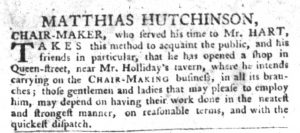What was advertised in a colonial American newspaper 250 years ago today?

“MATTHIAS HUTCHINSON, CAHIR-MAKER, who served his time to Mr. HART.”
Matthias Hutchinson published an advertisement in the March 22, 1768, edition of the South-Carolina Gazette and Country Journal “to acquaint the public, and his friends in particular, that he has opened a shop in Queen-street.” Hutchinson, a “CHAIR-MAKER,” proclaimed that he would pursue his occupation “in all its branches,” signaling to prospective customers that he was prepared to undertake jobs involving any aspect of constructing chairs. He also advanced some of the most common appeals made by merchants, artisans, and shopkeepers in their advertisements for consumer goods and services during the eighteenth century. He promised fair prices (“reasonable terms”) and efficient service (“quickest dispatch”).
In addition to those marketing strategies, Hutchinson also adopted an appeal most frequently deployed by artisans: he promoted his qualifications, especially his training. He did not introduce himself to the public merely as a “CHAIR-MAKER” but instead as a “CHAIR-MAKER, who served his time to Mr. HART.” In other words, Hutchinson had completed an apprenticeship in Hart’s workshop. He assumed that readers of the South-Carolina Gazette and Country Journal were already familiar with Hart’s work and depended on his former master’s reputation as he attempted to cultivate his own professional identity among prospective customers in Charleston and beyond. Hutchinson considered this particularly imperative, opting to establish his credentials before he even mentioned his location or made appeals to price and customer service. Those credentials also enhanced his credibility when he assured potential clients that they “may depend on having their work done in the neatest and strongest manner.” His chairs were both attractive and sturdy, results produced thanks to the skills that Hutchinson developed via his training by Hart.
When he established his own workshop, Hutchinson identified his apprenticeship as an advantage that prospective customers would value when considering whether to entrust their business to the newcomer. Having labored in Hart’s workshop, he had participated in the production of chairs associated with his former master, contributing to the senior artisan’s reputation. Now Hutchinson sought to mobilize Hart’s reputation as a testament to his own qualifications and skill by noting that he had “served his time to Mr. HART.” More than any other appeal to prospective customers, Hutchinson made that the focal point of his identity as an artisan and entrepreneur.
